A vision based hand gesture recognition system for dynamic user interface using bare hands tracker [ROI] is presented in this paper. The paper comprised of implementation details on efficient algorithm for initialization of vision based histogram tracker which incorporates camshaft algorithm for detecting of hand posture in the input image and effective algorithm for tracker point initialization and exit of tracking with two unique gestures by calibration, skin detection and tracking of ROI. This paper aiming intention to examine the effectiveness of the Cam Shift algorithm, with tracker point initialization and exit input command tracking, as a general-purpose hand and face tracking approach. In this case there were no assumptions have been made about the palm to be tracked.
Keywords |
| Tracking, ROI, HCI, Camshift, features. |
INTRODUCTION |
| The vocabulary of human hand gesture communication has many variations. Hand gestures have been a mode of
nonverbal interaction widely used. Visual surveillance is very important aspect in moving target tracking, video
compression and automatic applications such as visual analysis of the key technologies. Majority of applications
require target tracking algorithm in the block, illumination change and the goal of scaling, rotation, is robust [1-2].
Meanwhile, the tracking algorithm also needs to consume as little as possible time to meet the real-time requirements.
So an efficient tracking algorithm camshift is one of the effective solutions in incorporating tracker for gesture
recognition system [3-4]. |
| A. CAMSHIFT ALGORITHM |
| The Continuously Adaptive Mean Shift Algorithm (CamShift) is an adaptation of the Mean Shift algorithm for hand
tracking that is intended as a step towards palm and face tracking for a perceptual user interface. CamShift Algorithm
and extend a default implementation to allow tracking on type of feature spaces and arbitrary number is adapted in this
approach. In order to compute the new probability that a pixel Value belongs to the target model, it is necessary to
weigh the multidimensional histogram with a simple monotonically decreasing kernel profile prior to histogram backprojection |
| B. THE CAMSHIFT ALGORITHM |
| The CamShift algorithm can be summarized in the following steps, |
| 1. Set the region of interest (ROI) of the probability distribution image to the image. |
| 2. Select an initial location of the Mean Shift search window. The target distribution to be tracked will be the
selected location. |
| 3. Calculate a color probability distribution of the region centered at the Mean Shift search window. |
| 4. Iterate Mean Shift algorithm to find the centroid of the probability image. Store the zeroth moment
(distribution area) and centroid location. It is used to solve system of nonlinear equations. It can find solution
near the critical point easily. For this, it uses local parameterization continuation technique [4, 5]. |
| 5. For the following frame, center the search window at the mean location found in Step 4 and set the window
size to a function of the zeroth moment. Go to Step |
| C. CONTINUOUSLY ADAPTIVE DISTRIBUTIONS |
| The probability distribution image (PDF) may be determined using any method that associates a pixel value with a
probability that the given pixel belongs to the target. Histogram Back-Projection is a common method generally known.
On way to generate the PDF, an initial histogram is computed at Step 1 of the Camshift algorithm from the initial ROI
of the filtered image. |
| The histogram used in Bradski (1998) consists of the hue channel in HSV colour space, multidimensional
histograms however from any colour space may be used. Quantizing histograms into bins, this reduces the
computational and space complexity and allows similar colour values to be clustered together. The histogram bins are
then scaled between the minimum and maximum probability image intensities using Equation. |
 |
| Where x(i)and y(i) are the ithpixel in the segmented region and k denotes the number of pixel in the region. To track
the gesture N number of frames is taken and centroid values i.e. the x and y co-ordinates are calculated then we can
find the output as like in fig 1 Different gesture pattern will be generated then it is resized and converted into binary
image. |
BLOCK DIAGRAM |
| Gesture recognition is important for developing an attractive alternative to prevalent human computer interaction (HCI)
modalities. Gesture recognition is important for developing an attractive alternative to prevalent human–computer
interaction modalities. Gesture recognition is important for developing an attractive alternative to prevalent human–
computer interaction modalities. The system design shown in figure 2 depicts the techniques used for designing a
dynamic user interface which initializes by acquiring image or video of the gestures from user. |
| The different hand gestures considered are the sequences of distinct hand gestures. A given hand gesture can undergo
motion and discrete change. These gestures are distinguished based on the nature of motion. The real time recognition
engine is developing which can reliably recognize these gestures despite individual variations. The engine also has the
ability to detect start and end of gesture sequences in an automated fashion. |
ALGORITHMS |
| A.TRACKING ROI WITH VISION HISTOGRAM BASED TRACKER |
| The steps involved in process are as shown in fig 3 and detailed in following steps. |
| 1. System objects are created by reading video frames in creating BBOX of object to be tracked |
| 2. By considering the first frame which contains object to be traced and converting image to HSV color space. |
| 3. The object is set based on hue color space of first video frame. |
| 4. Display the result that is by drawing box around the object to be traced in hue channel distinguished from
background. |
| 5. Hence after the display of results the video can be loaded. |
| Vision Histogram tracker results a histogram system object which computes the frequency distribution of elements in
each input matrix. Running histogram defines the successive calculation of calls in step method this property is set to
true to enable computing the running histogram. The object will be tracked by concentrating histogram of pixel values
hence called histogram based tracking which incorporates CAMSHIFT. The boundary box[BBOX] of the tracked
object is characterized using step method with ‘I’ as input image and ‘H’ as histogram based tracked object, using
‘Initialize object’ we have to identify the object to be tracked by setting initial search window, the boundary box is of
the ingredients specified by [x y width height].The orientation of BBOX determines the angle between major axis and x-axis of ellipse which has the same second order moments like object, range of the object will be from -π/2 to π/2.The
confidence SCORE indicates whether the BBOX returned is having tracked object, the score is of the values between 0
and 1, the maximum confidence is equal to 1. |
| B. INITIALIZATION (START) AND EXIT (STOP) OF TRACKER OPERATION |
| The start gesture indicates that user can start giving input to system and until the user uses stop gesture until this the
input is accepted and detected by system. Meanwhile other operations gestures are taken care that they should not be of
the same type defined for start and stop operations. |
| 1. The start and stop operations get start from acquiring input image and tracking the ROI. |
| 2. The tracking of input frames is limited to 500 frames and tracker will time out after 500 frames to initialize
with new input. |
| 3. The calibration operation is done for 20 iterations to give color samples to the system. |
| 4. The next step is to create the bounding box around the ROI to track the object by calculating the centroid of
ROI. The threshold value of input samples to system is defined as 3 for creating bounding box if it exceeds
threshold value. |
| 5. To make ‘ON’ of tracking of input signal limit the value of input samples of calibration to system with range
of ratio1<1.6 && ratio1>0.7 for folding hand shown in fig 4. |
| 6. The center value of the BBOX is then calculated using x and y coordinates. Once the center value is
recognized which initializes the tracker or else it’s a STOP gesture. |
INTERPRETATION OF RESULTS |
| Fig 5 shows the skin colour calibration of the hand signal at a particular subplot in the mat lab window and details
the skin colour calibration of the hand signal at a particular subplot in the mat lab window , Fig 6 indicates area
selected for calibrated object i.e. Hand colour at different regions. Here, the values from area selected and stored
for the dynamic hand detection is done by the camshaft algorithm. Fig 7 shows the initialized tracker point from
where actual detection of input starts. Fig8 shows start of input command to system from keeping hand motion in
start gesture only figure 9 shows stop gesture which is unique gesture used to stop detection and recognition
operation of system and start with new input. |
CONCLUSION |
| This paper effectively represents an effective algorithm for tracker point initialization and exit of tracking ROI in a
comfortable means of way with two unique gestures for start and stop of tracker operation. It is very important
issue in gesture recognition and detection with continuously adaptive mean shift algorithm (Camshift). camshift is
an excellent real-time tracking algorithm. However, real-time tracking for certain occasions, such as real-time
demanding, butte video capture device IO occupy a larger proportion of the time, how to further improve the
calculation speed Camshift algorithm remains a serious problem. In this paper, the calculation of the tracking
process and the amount of data to model their impact on algorithm performance Camshift algorithm can reduce the
computing time at the same time a certain extent, to overcome the background noise. |
Figures at a glance |
 |
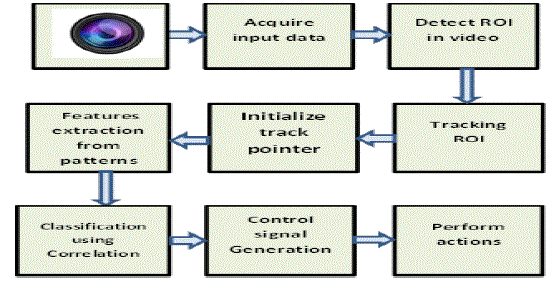 |
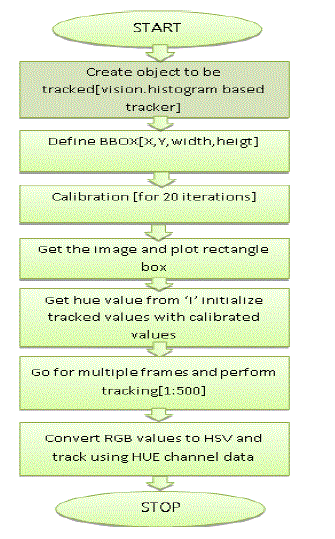 |
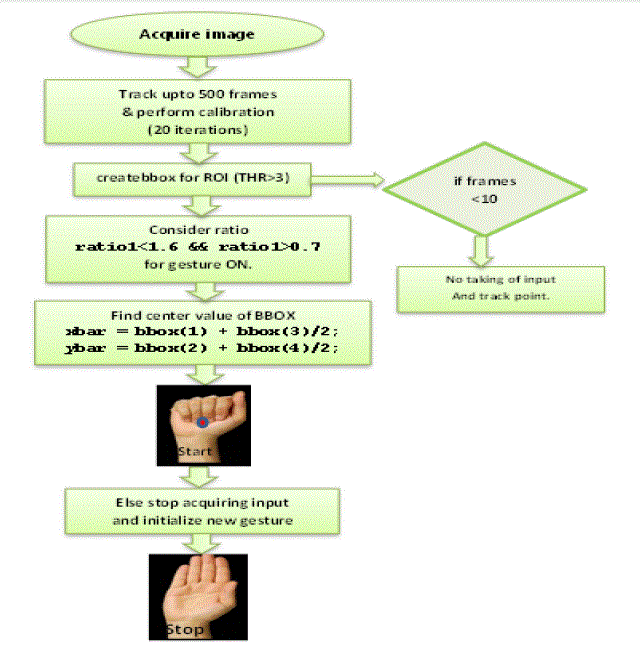 |
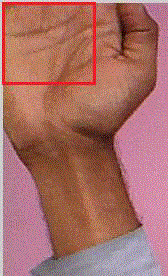 |
| Figure 1 |
Figure 2 |
Figure 3 |
Figure 4 |
Figure 5 |
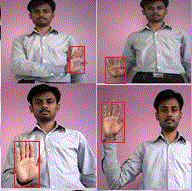 |
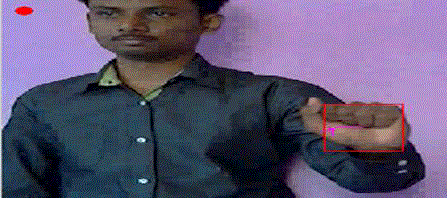 |
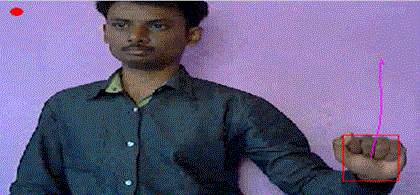 |
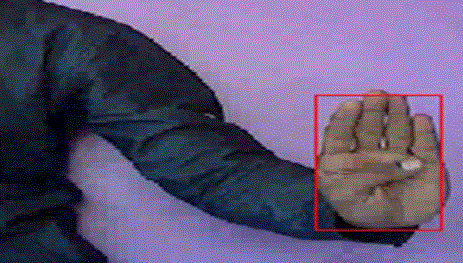 |
| Figure 6 |
Figure 7 |
Figure 8 |
Figure 9 |
|
References |
- Bradski G R. ‘Real time face and object tracking as a component of a perceptual user interface’. In Proceedings of the 4th Workshop on Application of Computer Vision. Princeton, USA: IEEE, 1998.
- Comaniciu D, Ramesh V, Meer P. ‘Kernel-based object tracking’. IEEE Transactions on Pattern Analysis and Machine Intelligence, 25(5): 564-577, 2003.
- Comaniciu D, Meer P.„A robust approach toward feature space analysis‟. IEEE Transactions on Pattern Analysis and Machine Intelligence, 24(5): 603-619, 2002.
- Collins R T, Liu Y X, Leordeanu M. ‘Online selection of discriminative tracking features‟. IEEE Transactions on Pattern Analysis and Machine Intelligence, 27(10):1631-1643. 2005.
- Yoo-Joo Choi, Je-Sung Lee and We-Duke Cho, „A Robust Hand Recognition In Varying Illumination‟, Advances in Human Computer Interaction, Shane Pinder (Ed.), 2006.
- N. Conci, P. Cerseato and F. G. B. De Natale, ‘Natural Human- Machine Interface using an Interactive Virtual Blackboard‟,InProceeding of ICIP 2007, pp. 181-184, 2007.
- S. Mitra, and T. Acharya, „Gesture Recognition: A survey‟,IEEE Transactions on Systems, Man and Cybernetics (SMC) - Part C: Applications and Reviews, vol. 37(3), pp. 211-324, 2007.
- Fukunaga, K., ‟Introduction to Statistical Pattern Recognition‟, 2nd Edition. Academic Press, New York, 1990.
- Chetan.S and Dr.M.Z.Kurian, “An Efficient Algorithm for Hand Segmentation” national Conference, E-Innovation-2013,atShridevi Institute for Engineering and Technology, Tumkur,23rd March 2013.
- Chetan.S and Dr.M.Z.Kurian, “A Sensorless Approach for HCI Using Gesture Recognition” National level Technical paper presentation and Conference, technika-2013, Akshaya Institute of Technology, Tumkur, 14thMarch 2013.
- Chetan.S and Dr.M.Z.Kurian, “Hand segmentation using camshiftalgorithm”‘International Journal of Graphics and Image Processing (IJGIP),Vol 3 issue 2, ISSN 2249 – 5452, July 2013.
|